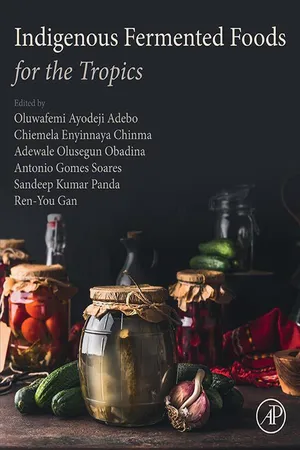
Indigenous Fermented Foods for the Tropics
- 638 pages
- English
- ePUB (mobile friendly)
- Available on iOS & Android
Indigenous Fermented Foods for the Tropics
About this book
Indigenous Fermented Foods for the Tropics provides insights on fermented foods of the Tropics, particularly Africa, Asia and South America, highlighting key aspects and potential developments for these food products. Sections provide an overview on the production and composition (nutritional, physicochemical, health beneficial and microbiota) of these indigenous fermented foods in the tropics, innovative techniques for investigating the composition of these fermented food products and improvement of the fermentation process to yield better nutritional constituents, health beneficial components and sensory qualities, and safety aspects to be considered in fermented foods. Other sections provide insights into the packaging and marketing of these food products as well as future prospects of fermented foods in the tropics. This book provides new perspectives and recent information to complement existing texts on indigenous fermented foods serving as a valuable reference text for detailed insights into indigenous fermented foods of the tropics.- Discusses fermented foods from the Africa, Asia, and South America based on the raw materials used- Offers innovative techniques for improving these indigenous products and investigating their composition as well as upgrading traditional technologies used in the production of fermented products- Covers the role of technology and innovations in the quest for enhancing quality, and safety of fermented foods as demand for fermented food and beverage products is increased
Frequently asked questions
- Essential is ideal for learners and professionals who enjoy exploring a wide range of subjects. Access the Essential Library with 800,000+ trusted titles and best-sellers across business, personal growth, and the humanities. Includes unlimited reading time and Standard Read Aloud voice.
- Complete: Perfect for advanced learners and researchers needing full, unrestricted access. Unlock 1.4M+ books across hundreds of subjects, including academic and specialized titles. The Complete Plan also includes advanced features like Premium Read Aloud and Research Assistant.
Please note we cannot support devices running on iOS 13 and Android 7 or earlier. Learn more about using the app.
Information
Table of contents
- Cover
- Title page
- Table of Contents
- Copyright
- Contents
- List of contributors
- Foreword
- Preface
- List of Illustrations
- List of Tables
- Chapter 1 : An insight into indigenous fermented foods for the tropics
- Chapter 2 : African cereal-based fermented products
- Chapter 3 : Asian fermented cereal-based products
- Chapter 4 : South American fermented cereal-based products
- Chapter 5 : African legume, pulse, and oilseed-based fermented products
- Chapter 6 : Asian fermented legumes, pulses, and oil seed-based products
- Chapter 7 : South American fermented legume, pulse, and oil seeds-based products
- Chapter 8 : African fermented fish and meat-based products
- Chapter 9 : Asian fermented fish and meat-based products
- Chapter 10 : South American fermented fish and meat-based products
- Chapter 11 : African fermented dairy-based products
- Chapter 12 : Asian fermented dairy-based products
- Chapter 13 : South American fermented dairy-based products
- Chapter 14 : African fermented vegetable and fruit-based products
- Chapter 15 : South American fermented fruit-based products
- Chapter 16 : African fermented root and tuber-based products
- Chapter 17 : Asian fermented root and tuber-based products
- Chapter 18 : South American fermented root and tuber-based products
- Chapter 19 : Fermented foods and gut microbiome: a focus on African Indigenous fermented foods
- Chapter 20 : Fermented foods and immunological effects in humans and animal models
- Chapter 21 : Metagenomics for the identification and characterization of microorganisms in fermented foods
- Chapter 22 : Metabolomics and its application in fermented foods
- Chapter 23 : Proteomics and transcriptomics and their application in fermented foods
- Chapter 24 : Data-driven innovation and 4th industrial revolution concepts for the development and improvement of fermented foods
- Chapter 25 : Starter cultures: an insight into specific applications in flavoring and health promotion
- Chapter 26 : Bioactive constituents and potential health benefits of fermented seed products
- Chapter 27 : Equipment and machinery for improving the fermentation process of indigenous foods
- Chapter 28 : Novel food processing techniques and application for fermented foods
- Chapter 29 : Sensory perspectives into indigenous fermented foods in the tropics: challenges and opportunities
- Chapter 30 : Occurrence of mycotoxins in fermented tropical foods
- Chapter 31 : Presence of pathogenic microorganisms in fermented foods
- Chapter 32 : Occurrence of biogenic amines in fermented foods
- Chapter 33 : Contamination of fermented foods with heavy metals
- Chapter 34 : Packaging and packaging technology for indigenous fermented foods in the tropics: challenges and opportunities
- Chapter 35 : Marketing practices to promote indigenous fermented alcoholic beverages in the tropics
- Chapter 36 : Future prospects for indigenous fermented foods from the tropics
- Index
- A